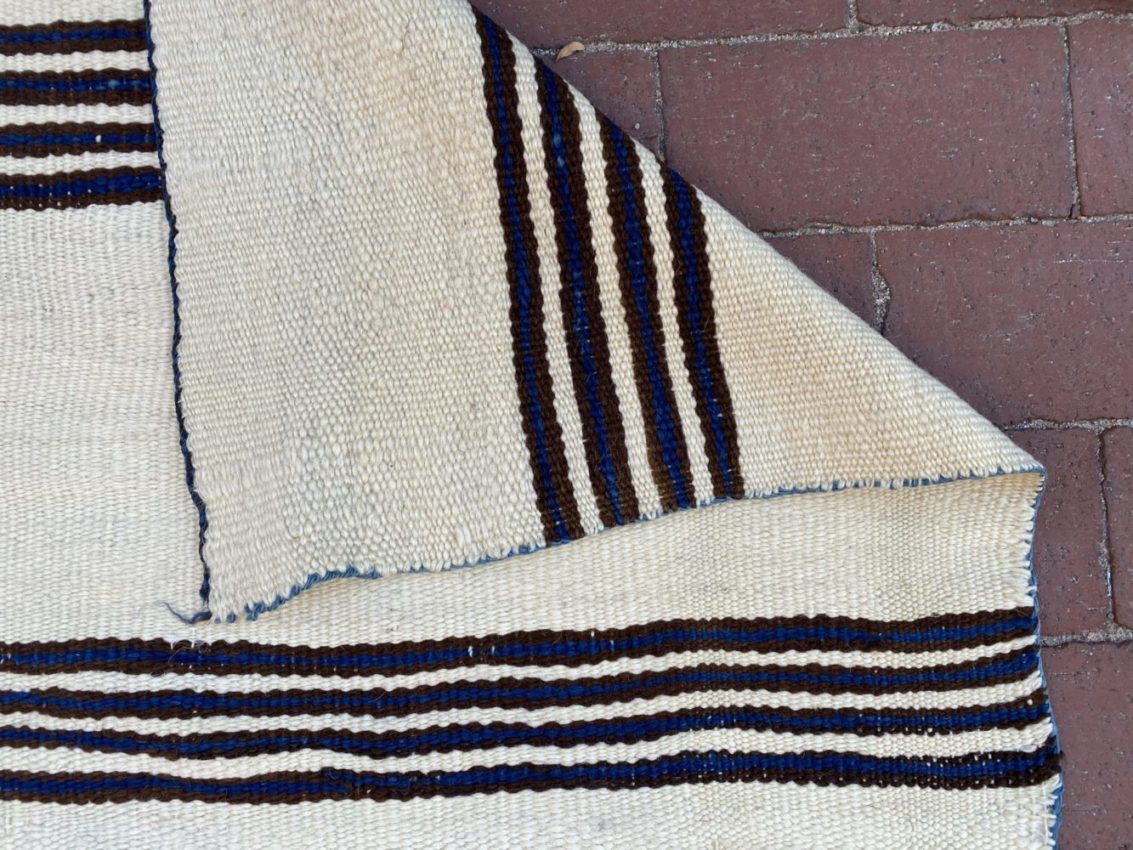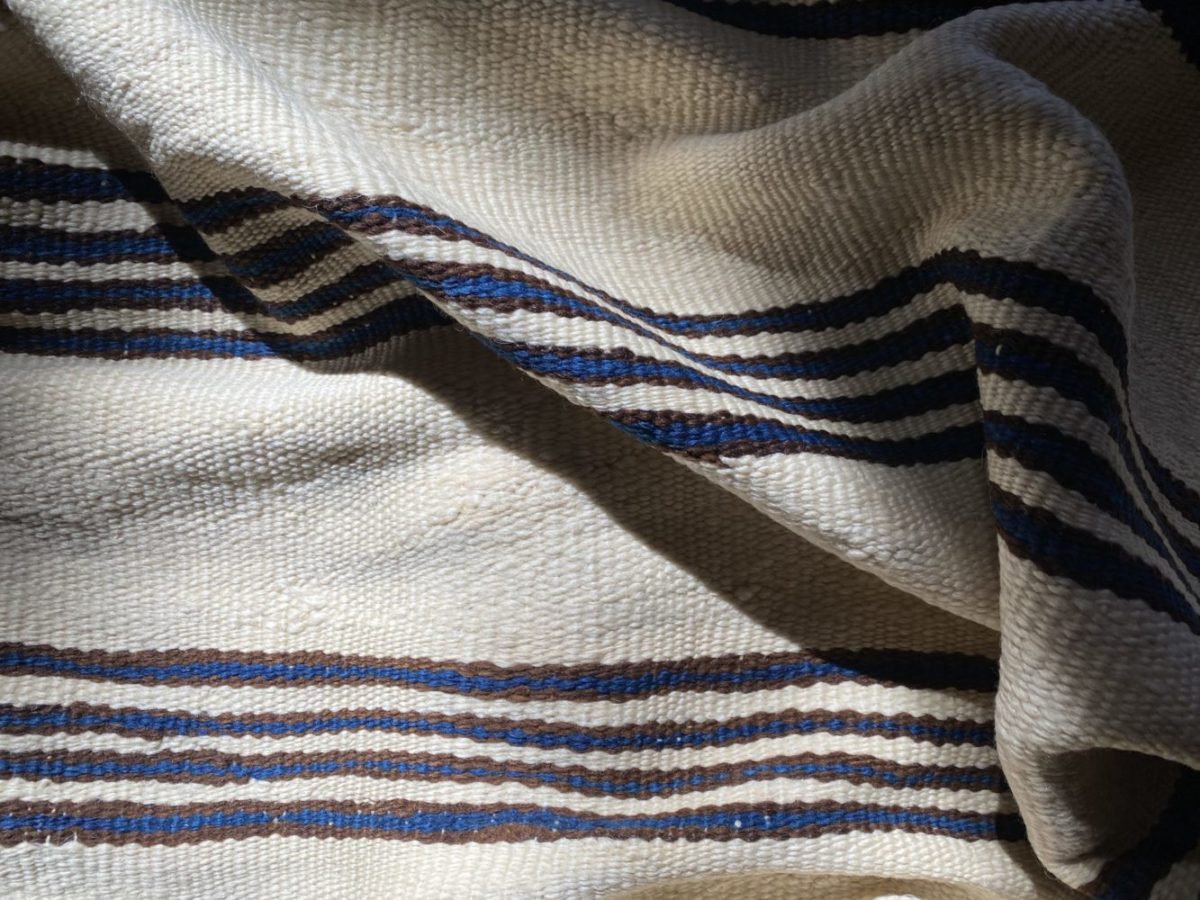
Of Banded Blankets and Finding God
- by Jamie Compton
- in A closer look... My Thoughts on Native Art New Gallery Item
- posted October 20, 2020
A New Find
A beautiful and early banded, Navajo blanket came into my gallery last week. My understanding on this type of blanket puts the date around the middle 19th century, perhaps earlier. It measures 65” by 45.5” and has four colors, natural white, natural brown, dark indigo blue and light indigo blue. There are 7 groups of 4 bands, each band a system of brown centered with dark indigo. These 7 groups are roughly spaced on a field of golden white.
My criteria on the early dating comes from 3 points. The first is the presence of churro wool, in particular, early churro wool. The qualities that distinguish this type of wool are the long, parallel fibers, the golden hue to the white wool and the way the wool takes the dye so strongly and with such clarity. Later wool that is not early churro does not take the dye so consistently. These qualities taken together mean an early churro wool of the type that lasted through the mid 1860s.
Secondly, the 2 cords (each cord being two plies) making up the side or weft selvage is a light indigo blue. This color of selvage is characteristic of a classic period weaving which would date around 1865 or earlier. This is particularly true of Hopi side selvage – the earlier blankets almost always have this light blue colored wool. The selvage on this blanket is all original and there has been no restoration. It’s very rare on a blanket this early to find all the selvage intact. The photo below shows the light blue side or weft selvage.
Lastly, the few lazy lines that are present are done in a fashion more typical of classic period weavings, in that the sectional line (lazy line) is created like a wave of energy, pulling in, like a spiral, the wool around it. Later period sectional lines are more clean cut and don’t involve this sort of weft movement. The below photo shows one of these wave like lazy lines.
Navajo or Pueblo Woven?
I believe that this classic period weaving is Navajo woven, even though it has the appearance of a Pueblo blanket. The Pueblos were the earliest weavers and their system of weaving was most commonly a simple banded pattern as seen with this blanket. When the Navajo migrated south into the Pueblo area over 800 years ago, they took up the Pueblo type of weaving themselves, excelling in the art form to the present day.
There is evidence on two corners that this blanket had embellished corner tassels typically created by Navajos. There are two pieces of light indigo blue wool in the corners not associated with the selvage. These are likely remnants of corner tassels. The presence of lazy lines excludes Hopi, since Hopi weavers never wove with lazy lines. However, this could be Zuni since Zuni weavers did use lazy lines, but the aesthetic is not Zuni, in contrast, it’s Hopi or Navajo. In the end, I assume Navajo woven either for a Navajo person or a Pueblo person.
Banded Blankets
For a good number of years banded blankets have been my most favorite blankets to collect. A primary condition here is they need to be early, at least before 1890 if not 1870. Over the last 30 years of collecting my eye has been increasingly leaving the Navajo eye dazzler designs in favor of the simpler banded ones. At first consideration, collecting banded blankets may appear a bit boring. The opposite of this is true. The subtle and not so subtle variations in banding systems, from densities, to spacing, to colors, etc., allows for an infinity of options. As a result, I have yet to tire around my focused interest.
There is something fundamentally intriguing as well as comforting with banded blankets. I am most reminded of the horizon line when I see bands in a blanket. A horizon line is one of the most stabilizing land features in that it allows for us to orient to our world. It is the platform that allows us to literally find our feet. With Navajo blankets, the use of the sectional, or lazy line, gives a gentle fracturing to these planes of weaving making them all the more interesting, like fault lines crossing through a roadside cut.
God as Found in Navajo Blankets
My search for answers about why these blankets are so beautiful and powerful has me often writing about the big questions of life. The qualities of these blankets, including the sleek worsted woolen yarns, the depth of the colors, the way the designs seem to go well beyond the borders, and the feel of them wrapped around my body are just some of the traits that create this relationship. Even more powerful is the deep-down visceral state I get of feeling completely satisfied.
Within this feeling of satisfaction is the acknowledgment that these blankets hold the answers to why we are here. In my writings over the years to try and solve this riddle, I have come to a set of perspectives that, while not answering the question, help me establish a better sense of my place in the world.
God is Horizontal
The story that comes out of these blankets is that God is horizontal and Humans vertical. Stated differently, horizontal is the point of rest, the place of sleep, the point of death. Humans, in their verticality, thrive in life by fighting to keep going forward and, in a way, avoid horizontal in hopes of finding the answer. One of the most beautiful things about going to bed each night is my willingness to let go of my very life, and let my body rest and be one with the infinite place of sleep. When I wake up the next morning it’s like being reborn, as I pull myself together to restart my actions trying to get somewhere better than yesterday before it’s time to settle in, once again, to the horizontal. In the end, all matter settles out into the horizontal, a place of equilibrium where complete rest finally answers all the questions.
The Oscillation or Beginning of Vertical
It’s my understanding, by listening to a famous physicist, that just after the Big Bang the universe dispersed itself with complete evenness in expansion. For a moment, there was no difference in space relative to anything. It was all equal. A moment later a minor blip occurred, some sort of oscillation, that sent a ripple through this expanding matrix of our universe. It is because of this oscillation that matter formed and why we are here. It is this oscillation that we see and experience each and every day: light and dark, hope and despair, yin and yang, yes and no. The shakeup that happened at almost the beginning of time is reflected in us trying to make it to the end of each day, to sleep, and to get up and try it again, day after day, year after year, life after life. I imagine that if we were able to fix this oscillation, then nothing would exist and all of everything would immediately vanish. So, in a big way, I’m glad that I’m not able to really answer this big question, because if I could, well, then this sentence would end everything.
This brings me back to the horizontal. The banded blankets allow me to rest and feel at peace. Not to the point where I am gone, but instead one foot firmly here in the life of the vertical, the other foot in the horizontal, where all is good, and I can rest and not worry about the next moment. I imagine the weaver weaving away and tuning into that creative, ethereal space as they lay the weft down. Horizontal is the easiest way to add complexity to the blanket. Weaving the horizontal, I imagine, allows the weaver to also enter a God like space of connection to the earth with its layers upon layers. To make vertical in a blanket, weft is laid down one horizontal step at a time, a much harder path. The vision to go vertical in a blanket requires more planning in the mind of the creator. It is in this very challenge that human energy goes to the vertical, asking for some answer from the obvious horizontal.
Forgive me for my indulgence here, but taking things down to the bare bones is, for me, the best way to find out what’s really going on. I believe horizontal is where everything ends up in the end. Until that happens, vertical will continually be established in trying to figure out the answer. It’s interesting to note here that a blanket, specifically the serape format, is woven in the horizontal, but when it gets worn, it goes to the vertical, which makes sense. The creator is with God and the horizontal as the blanket is made, but once it is worn and claimed by another, then the horizontal goes vertical, and the man or woman goes forth with a feeling of having God with them, one foot in the horizontal, the other in the active life of the vertical.
Mantas and Chief’s Blanket
Interesting to also note that Chief’s blankets and mantas are woven in the horizontal but also worn in the horizontal. If one were to look back at all the chief’s and manta blankets, one would see a ponderous number in the horizontal format without hardly any vertical. Here there is a subconscious path that gets presented in our visible world, that being how the manta, especially a 1st phase Ute, a truly horizontal blanket, allows one the regal space of being one with God.
In Conclusion
Finally, there is obviously verticality in banded blankets as well. Just look at the blanket herein that I described above. The simple bands are two bands of brown centered with indigo blue; three colors stacked adjacent to each other. The vertical stacking allows for the duality of warm next to cool, brown next to blue. These are two complementary colors, and their proximity gives added satisfaction. The coziness of these two colors together gives much pleasure. Pleasure is a highly vertical experience, but a vertical experience that can have the calming effect of bringing one to a place of horizontality.
In the end, this is what a simple, banded blanket does to me, at least on an analytical level, which can take a lot of work. In reality, I love to have these blankets around me and it’s really the feeling that I get from them, not the thought process, that has me in such a pleasurable space. A final photo below shows these colors in the warm afternoon sunlight coming in from my window. I can’t help to feel that when gazing upon this blanket, I am one step closer to God.





Comments
mary catalina
October 30, 2020 at 4:31 amstripes organize the chaos of the universe – see Agnes Varda movie, The Gleaners and I
and there is a book about stripes – The Devil’s Cloth: A History of Stripes
Book by Michel Pastoureau
Jamie Compton
November 12, 2020 at 8:43 pmMary… bless you for reaching out and giving me your brief thoughts…. thank you, I will search for the movie and the book alike… sounds like an extending adventure.
James